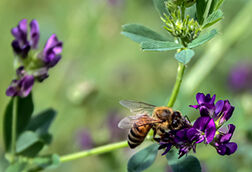Use caution when donating hay
In response to the recent wildland fires in Oklahoma, an outpouring of hay donations to help feed the many farm animals is being experienced in the area. We are thankful for this continued outstanding show of support from not only Oklahomans, but also friends from across the nation.
During this time, we also want to take steps to prevent any unwanted consequences such as movement of red imported fire ants from restricted areas.
As a result, the Oklahoma Department of Agriculture, Food and Forestry along with Oklahoma State University Extension will be surveying sites for the red imported fire ant where this hay is stored. This will consist of placing RIFA bait tubes when temperatures are between 65 degrees F and 95 degrees F. This is important because if temperatures are too cold or too hot, the fire ants will not be as active.
In about 40 to 45 days when the wildland fire situation has hopefully settled some and when the weather is more appropriate, ODAFF will hold a public meeting with producers to help educate them about the eradication of fire ants in order to keep the area free of fire ant restrictions.
Under what conditions can baled hay leave the quarantine area without restrictions?
Baled hay that meets any of the requirements below is not regulated and has no movement restrictions:
For baled hay that is stacked, all bales except the bottom layer that is in direct contact with the ground.
Hay that is cut, baled, loaded and shipped without storage.
Baled hay that is stored on an impervious surface such as hard pan (highly compressed soil), asphalt, concrete, etc.
Baled hay that is stored elevated above the soil on pallets or tires or stored on landscaping cloth placed over the soil.
As a reminder, stored hay bales not touching the soil are assumed to be free of fire ants.
The red imported fire ant was imported into the U.S. around the 1930s and has spread to infest more than 260 million acres of land primarily in 11 southeastern states, including all or portions of Florida, Georgia, South Carolina, North Carolina, Virginia, Tennessee, Alabama, Mississippi, Arkansas, Texas and Oklahoma. In Texas, the red imported fire ant is thought to have an estimated economic impact of $1.2 billion annually. These fire ants are pests of urban, agricultural and wildlife areas and can pose a serious health threat to plants and animals including humans.
As a result of the impact that the red imported fire ant poses, U.S. Department of Agriculture’s Animal and Plant Health Inspection Service has established a quarantine.
Under that quarantine, the following are regulated items:
Imported fire ant queens and reproducing colonies of imported fire ants.
Soil, separately or with other things, except soil samples shipped to approved laboratories. Potting soil is exempt, if commercially prepared, packaged and shipped in original containers.
Plants with roots with soil attached (containerized nursery stock, field grown and balled and burlapped nursery stock), except houseplants maintained indoors and not for sale (personal items).
Grass sod.
Baled hay and straw that have been stored in contact with the soil.
Used soil moving equipment, unless cleaned of all noncompacted soil.
Any other products, articles or means of conveyance when it is determined by an inspector that they present a risk of spread of imported fire ants due to its proximity to an infestation of imported fire ants.
Note: The following USDA link is to the nation’s June 2016 Imported Fire Ant Quarantine areas. On the Oklahoma map, this does not show Latimer County which should be included: https://www.aphis.usda.gov/plant_health/plant_pest_info/fireants/downloads/fireant.pdf.
If you have any questions, please contact Kenny Naylor, Director Consumer Protection Services, at [email protected] or 405-522-5879 or Courtney DeKalb at [email protected] or 405-522-5971.



